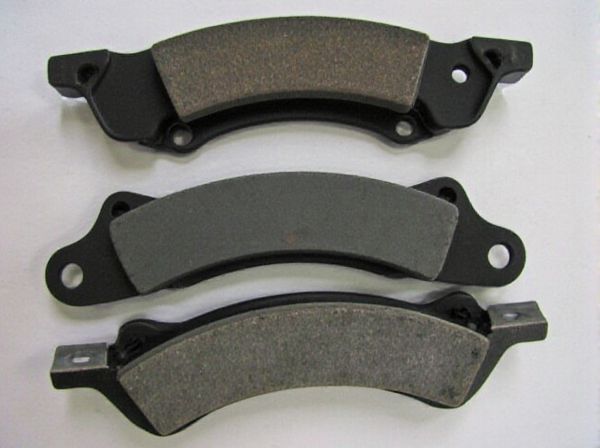
Photo illustration: Sintered Brake Linings vs Non-Asbestos Organic Linings
Sintered brake linings offer superior heat resistance and durability, making them ideal for high-performance or heavy-duty applications. Non-asbestos organic linings provide quieter operation and less wear on brake components, benefiting everyday driving comfort and safety. Choosing the right material depends on Your vehicle's usage, balancing performance needs with maintenance preferences.
Table of Comparison
| Feature | Sintered Brake Linings | Non-Asbestos Organic (NAO) Linings |
|---|---|---|
| Material Composition | Metallic particles fused under heat and pressure | Organic fibers, resins, fillers without asbestos |
| Performance | High friction, excellent braking strength | Moderate friction, smoother braking feel |
| Durability | Long-lasting, resistant to heat and wear | Shorter lifespan, less heat resistant |
| Noise Level | Can be noisy due to metallic content | Quieter operation |
| Environmental Impact | Contains metals, may cause more dust pollution | Eco-friendly, less harmful dust emissions |
| Cost | Higher cost due to materials and processing | Lower cost, budget-friendly option |
| Applications | Heavy-duty vehicles, high-performance braking | Passenger cars, light-duty vehicles |
Introduction to Sintered and Non-Asbestos Organic Brake Linings
Sintered brake linings consist of metallic particles fused under high heat and pressure, offering exceptional durability and heat resistance ideal for heavy-duty vehicles and high-performance braking systems. Non-asbestos organic (NAO) linings are composed of natural fibers, resins, and fillers, providing quieter operation and reduced environmental impact but generally lower wear resistance. Both types serve different vehicle requirements, with sintered linings favored for strength and longevity, while NAO linings prioritize noise reduction and eco-friendliness.
Material Composition: Sintered vs. Non-Asbestos Organic
Sintered brake linings consist of metallic particles fused under high temperature and pressure, offering superior heat resistance and durability in extreme conditions. Non-asbestos organic (NAO) linings utilize organic fibers, resins, and fillers, providing quieter operation and a softer friction material with less wear on the brake rotor. The metallic composition of sintered linings results in higher friction coefficients and longer lifespan compared to the fiber-based, environmentally friendly NAO options.
Key Performance Differences
Sintered brake linings exhibit superior heat resistance and wear durability compared to non-asbestos organic linings, making them ideal for high-performance and heavy-duty applications. Non-asbestos organic linings provide quieter operation and better initial bite but tend to wear faster under extreme temperatures and heavy loads. The enhanced friction stability and longevity of sintered linings result in improved braking consistency and safety for demanding driving conditions.
Heat Resistance and Thermal Stability
Sintered brake linings exhibit superior heat resistance and thermal stability compared to non-asbestos organic (NAO) linings, making them ideal for high-performance and heavy-duty applications. Their metallic composition allows them to withstand extreme temperatures without significant degradation, maintaining consistent braking performance under intense thermal stress. In contrast, NAO linings, primarily composed of organic fibers and fillers, tend to soften and wear faster at elevated temperatures, reducing their effectiveness and lifespan in demanding conditions.
Wear Rate and Longevity Comparison
Sintered brake linings exhibit a lower wear rate due to their metallic composition, which enhances durability under high-stress braking conditions. Non-asbestos organic (NAO) linings offer softer friction materials that tend to wear faster, resulting in reduced longevity compared to sintered variants. The superior thermal conductivity and structural integrity of sintered linings contribute to extended life spans, making them preferable for heavy-duty applications requiring consistent performance.
Braking Efficiency in Different Conditions
Sintered brake linings offer superior braking efficiency in high-temperature and wet conditions due to their metallic components, providing consistent friction and durability under extreme stress. Non-asbestos organic linings deliver quieter operation and better initial bite on dry surfaces but tend to wear faster and lose effectiveness when exposed to moisture or heat. Vehicles requiring reliable performance in diverse environments often benefit from the robust, long-lasting braking performance of sintered linings.
Environmental Impact and Safety
Sintered brake linings offer superior durability and braking performance, reducing brake dust emissions that contribute to air pollution compared to non-asbestos organic (NAO) linings. NAO linings, made from fibers and resins, generate less noise and are biodegradable, minimizing environmental harm during disposal but wear faster, increasing maintenance frequency. Both types prioritize safety, with sintered linings excelling in high-temperature applications and NAO linings providing smoother, quieter operation under normal driving conditions.
Cost and Availability Analysis
Sintered brake linings generally incur higher upfront costs but offer superior durability and performance, making them more cost-effective over time in heavy-duty applications. Non-asbestos organic linings are more affordable initially and widely available, catering to light vehicles with moderate braking needs. Market availability of sintered linings is concentrated in industrial and off-road sectors, while non-asbestos organic linings dominate consumer automotive replacement markets due to lower manufacturing complexity.
Typical Applications and Industry Preferences
Sintered brake linings are favored in heavy-duty and high-performance applications such as motorcycles, trucks, and industrial machinery due to their superior heat resistance and durability under extreme conditions. Non-asbestos organic (NAO) linings are preferred in passenger cars and light-duty vehicles for smoother operation, lower noise, and environmental compliance. Industries prioritize sintered linings for demanding environments requiring longevity and consistent performance, while NAO linings dominate in comfort-oriented, low-heat scenarios.
Choosing the Right Brake Lining for Your Needs
Sintered brake linings offer superior durability and high heat resistance, making them ideal for heavy-duty vehicles and high-performance braking conditions, while non-asbestos organic (NAO) linings provide quieter operation and less wear on brake rotors, suited for everyday driving and lighter loads. Selecting the right brake lining involves considering vehicle type, driving style, and environmental conditions to balance performance, longevity, and cost-effectiveness. Evaluating factors such as friction stability, noise levels, and maintenance frequency ensures optimal safety and braking efficiency tailored to your specific needs.
 caratoz.com
caratoz.com